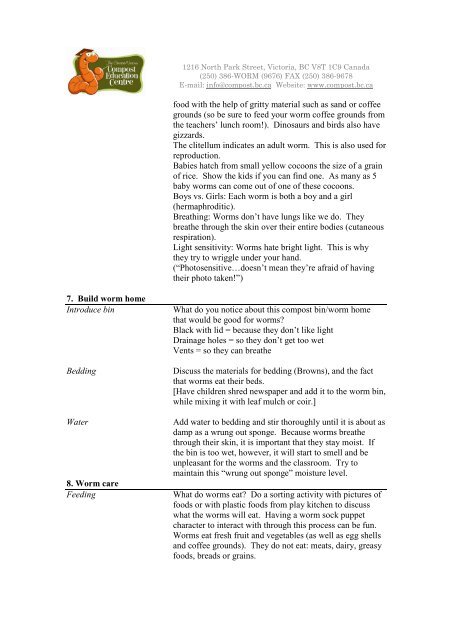Wrigglers At Work Worm Composting Lesson Plan - The Greater ...
Wrigglers At Work Worm Composting Lesson Plan - The Greater ...
Wrigglers At Work Worm Composting Lesson Plan - The Greater ...
You also want an ePaper? Increase the reach of your titles
YUMPU automatically turns print PDFs into web optimized ePapers that Google loves.
1216 North Park Street, Victoria, BC V8T 1C9 Canada<br />
(250) 386-WORM (9676) FAX (250) 386-9678<br />
E-mail: info@compost.bc.ca Website: www.compost.bc.ca<br />
food with the help of gritty material such as sand or coffee<br />
grounds (so be sure to feed your worm coffee grounds from<br />
the teachers’ lunch room!). Dinosaurs and birds also have<br />
gizzards.<br />
<strong>The</strong> clitellum indicates an adult worm. This is also used for<br />
reproduction.<br />
Babies hatch from small yellow cocoons the size of a grain<br />
of rice. Show the kids if you can find one. As many as 5<br />
baby worms can come out of one of these cocoons.<br />
Boys vs. Girls: Each worm is both a boy and a girl<br />
(hermaphroditic).<br />
Breathing: <strong>Worm</strong>s don’t have lungs like we do. <strong>The</strong>y<br />
breathe through the skin over their entire bodies (cutaneous<br />
respiration).<br />
Light sensitivity: <strong>Worm</strong>s hate bright light. This is why<br />
they try to wriggle under your hand.<br />
(“Photosensitive…doesn’t mean they’re afraid of having<br />
their photo taken!”)<br />
7. Build worm home<br />
Introduce bin What do you notice about this compost bin/worm home<br />
that would be good for worms?<br />
Black with lid = because they don’t like light<br />
Drainage holes = so they don’t get too wet<br />
Vents = so they can breathe<br />
Bedding Discuss the materials for bedding (Browns), and the fact<br />
that worms eat their beds.<br />
[Have children shred newspaper and add it to the worm bin,<br />
while mixing it with leaf mulch or coir.]<br />
Water Add water to bedding and stir thoroughly until it is about as<br />
damp as a wrung out sponge. Because worms breathe<br />
through their skin, it is important that they stay moist. If<br />
the bin is too wet, however, it will start to smell and be<br />
unpleasant for the worms and the classroom. Try to<br />
maintain this “wrung out sponge” moisture level.<br />
8. <strong>Worm</strong> care<br />
Feeding What do worms eat? Do a sorting activity with pictures of<br />
foods or with plastic foods from play kitchen to discuss<br />
what the worms will eat. Having a worm sock puppet<br />
character to interact with through this process can be fun.<br />
<strong>Worm</strong>s eat fresh fruit and vegetables (as well as egg shells<br />
and coffee grounds). <strong>The</strong>y do not eat: meats, dairy, greasy<br />
foods, breads or grains.


